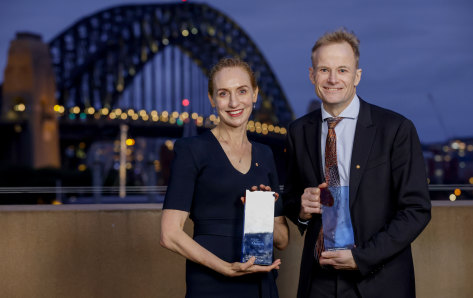This was published 5 months ago
Opinion
Their work saved my life: these two great Australians richly deserve their award
Garry Maddox
Senior writerIt’s still the most vivid – and most chilling – phone call of my life. Late one Friday afternoon four years ago, as I walked across a park on the way home, Associate Professor Robyn Saw from Royal Prince Alfred Hospital called with the results of a biopsy from earlier in the week. I still remember the words.

Professor Georgina Long and Professor Richard Scolyar, the Australians of the Year for NSW.Credit: Salty Dingo
I’m shocked, she said. It’s melanoma, metastasised.
Frozen on the spot in the park, I asked whether she was shocked because of how much cancer there was or how far it had advanced. “Frankly, both,” she said.
Thus began a new phase of life with regular visits to the Melanoma Institute Australia, which is based in a low-rise modern building opposite the Mater Hospital in Wollstonecraft, and its treatment centre in what used to be a stately old house across the road.
“Frankly, both” was terrifying – even more so when I learnt more about what a diagnosis of a stage four melanoma meant. A decade earlier, there was no effective treatment for it.
Patients usually had just six to nine months to live after diagnosis, less if the cancer reached the brain. The best an oncologist could do was encourage them to enjoy what time they had left, get their finances in order, and arrange pain management for the palliative stages.
The survival rate beyond 6½ years was about 5 per cent.
But a revolution has taken place in that low-rise modern building under the institute’s co-medical directors, Professor Georgina Long and Professor Richard Scolyer, two passionate and laser-focused characters who have been named NSW’s 2024 Australians of the Year.
With the institute pioneering immunotherapy, a treatment that uses drugs to turbocharge the body’s immune system so it destroys cancer cells, the survival rate for advanced melanoma is now 56 per cent.
In my case, the effect of two powerful drugs called nivolumab and ipilimumab – only administered as a combined treatment for the first time three years earlier – was miraculous. Four treatments, three weeks apart, were enough to see dramatic reductions in the tumours all around my body.
While it’s awful to think about other patients from that treatment centre who have not been so lucky, Associate Professor Alex Menzies – another brilliant oncologist at the institute – considers me one of the 56 per cent who have made it through. From melanoma, metastasised, to effectively cured.
The institute still sees 2000 new patients a year, despite decades of “slip, slop, slap” and “no hat, no play” sun-awareness campaigns. So it has saved the lives of thousands of melanoma patients in the past few years.
Long, Scolyer and their team are trying to work out why other advanced melanoma patients have not responded so well to immunotherapy. As well as extending immunotherapy into certain types of breast, lung, head and neck, bladder, bowel and stomach cancers, their ambition is to have zero deaths from melanoma in Australia, which would be extraordinary.
And now, in the cruellest of twists, Long and the team are trying to save the life of Scolyer, who was diagnosed with an incurable brain tumour known as glioblastoma IDH wild-type, after a seizure while overseas in May.
Scolyer, a world-leading pathologist who won a lifetime achievement award at the Society for Melanoma Research Congress in Philadelphia last week, is bravely trying a groundbreaking new treatment based on what the institute has learned from treating melanoma with immunotherapy.
It’s such unknown territory that Scolyer recognises that, while it may not save his life, it could affect the quality of the time he has left with his wife, Katie, also a pathologist, and their three teenage children.
His treatment is being overseen by Long, a close friend who has admitted she couldn’t stop crying when she heard his diagnosis in a phone call.
The institute, the world’s largest not-for-profit organisation devoted to melanoma’s clinical care, research and teaching, is trying to crack a brain cancer that is just as insidious, just as lethal, as melanoma was a decade ago.
While the early results have been encouraging, both Long and Scolyer are well aware that the average survival time after a glioblastoma diagnosis is just 12 to 18 months.
So do they deserve all the acclaim that comes with the NSW Australian of the Year award because of all the lives they have saved? Or do they deserve it because of how they are calmly and courageously stepping into a brave new world of trying to overturn certain death from glioblastoma?
Frankly, both.
Garry Maddox is a senior writer for The Sydney Morning Herald.
Start the day with a summary of the day’s most important and interesting stories, analysis and insights. Sign up for our Morning Edition newsletter.